Just outside Austin Texas, a 10 minute drive from the international airport and 25 minutes from the Texan capitol building, a 10m sq ft factory sits nestled against the Colorado River. Giga Texas is the headquarters of Tesla, Elon Musk’s electric vehicle company. The business is valued (as of 30 Oct) at $618bn. It already has 20,000 workers at the facility and expects to hire an additional 40,000 to service the production of its Cyber Truck range. Ever the visionary, Musk has bought land locally to build housing which he plans to offer to workers at vastly subsidised rent. I can’t imagine they’ll be Fyre Festival-like makeshift pre-fabs either. According to reports, Musk’s utopia will be flush with gyms, restaurants, schools, bars, parks etc.
This mammoth (and it is mammoth – JCB’s facility in Uttoxeter is 1/20th of the size, and the largest Amazon logistics facility in Britain is in Dunfermline and is about 1m sq. ft) achievement is a monument to the shift in economic power, that has seen Texas attract a huge number of large US corporates from states with a richer history of big business.
To put things in to context, in 2022 Texas overtook New York to become the most populous state for Fortune 500 company HQs. As of 2023 Texas is home to 55 Fortune 500 firms (California has 53 and New York 50). Big tech companies Oracle and Hewlett Packard have moved their HQs to Texas. Non-tech companies like One World Alliance, Caterpillar, and Chevron have moved or are moving to Texas. Venture capital firms (Breyer Capital and 8VC) who normally would not have been found outside Silicon Valley and Manhattan are moving. Apple, Amazon and others have announced their intention to develop a significant presence in the Lone Star State.
Florida too has also attracted corporates looking to move to sunnier climes and a more favourable business environment than the one they currently have in the North East and Midwest. Some of the biggest names in hedge fund management have moved to the state, including Ken Griffin’s Citadel, Paul Singer’s Elliott Management, And D1 Capital. Blackstone, Deutsche Bank and Virtu Financial are other big firms relocating out of New York and to the South.
The macro-statistics are moving in the same direction. California remains the largest state in the US by GDP (it is 50% larger than Texas and 75% larger than the economy of New York). California, New York, and the District of Columbia also remain the wealthiest states in GDP per capita terms. And the big metro areas of New York-New Jersey, LA, San Francisco, and Boston are all significantly wealthier than the Texan hubs of Austin, Dallas and Houston, and the Floridian hubs of Miami-Fort Lauderdale and Tampa.
However dig in to the data over time, and you will find that between 2000-2021 GDP growth in metro areas of Austin, Dallas and Midland far out-paced GDP growth in San Francisco, Atlanta, Boston. Houston grew 50% more than the economy of New York and nearly twice as much as the economy of Chicago. And if you look at nominal GDP growth, Texas is growing at a much faster rate than both California and the similar sized state of New York. In both the pre- and post-Covid periods, Texas outgrew competitors (in GDP terms). It’s performance is marginally better than that of the other Southern big-hitter, Florida.
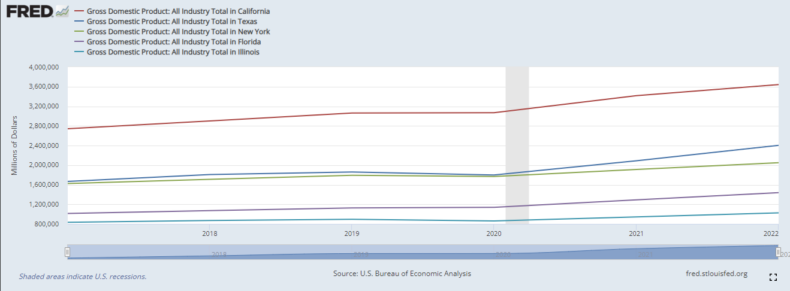
.
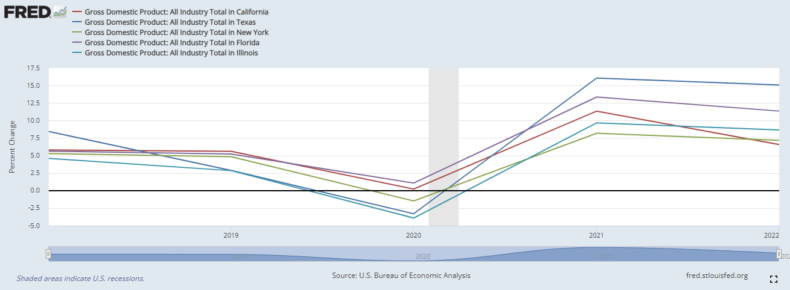
.
There are of course some of obvious policy reasons for this trend. Texas has lower tax rates, lighter regulations and more a more pro-business political environment. Texas levies no Corporation Tax, 0% Capital Gains Tax, and 0% Personal Income Tax. Florida also levies no personal income tax but does however charge 5.5% on corporates. New York comparatively levies a state Corporation Tax of 7.3%, a Capital Gains Tax of 8.82%, and a variable rate between 4-10% on Income Taxes. California charges 8.8% tax on Corporate Income, 13.3% on Capital Gains, and Personal Income Tax rates between 1-12%. The Tax Foundation ranks Florida as the 4th best state in the country for tax, with Texas at 13th. New York was one of the worst at 49th with California at 48th. Chief Executive Magazine published a poll showing Texas was the most popular state in America for doing business among CEOs.
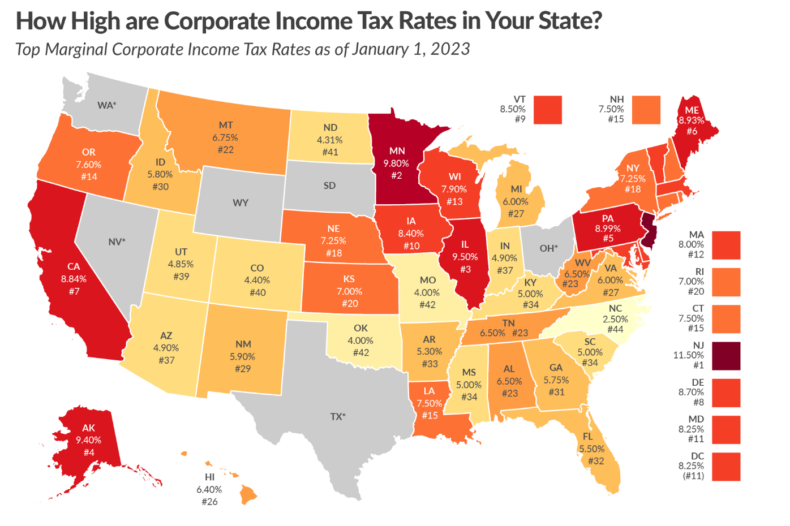
.
Despite a slimmed down revenue model, the State of Texas continues to run a relatively conservative budgets. Pew Charitable Trust noted that Texas had some of the deepest reserves in the country.
As well as taxes, housing costs are also low in Texas. This is not just because the state is huge (the largest state on the mainland US continent, at 268m sq miles, it is roughly the same size as Florida, Georgia, Alabama, Mississippi and Louisiana combined) but because the Texan legislature and Governor Gregg Abbott have prioritised the scrapping the regulation of land use that, in their words, ‘takes away the rights of Texas landowners’. He has introduced property tax exemptions and simplified building codes and regulations making it easier to get ‘stuff built’.
In 2021, Texas had 9 new residential construction permits authorised per 1000 residents, Florida had 10, the US average was 5.5, while California was 3, New York at 2 (which was the fourth lowest in the country). This is a long-running trend; Texas was one of the fastest growing home builders 10 years ago. It is not entirely surprising therefore that the average house price in Texas is roughly 10% less than the US average. And the average annual household income is 24% of the average price of a house (making housing affordable with access to credit). This compares to 19% in New York, 17% in Florida, 14% in the District of Columbia and 12% in California.
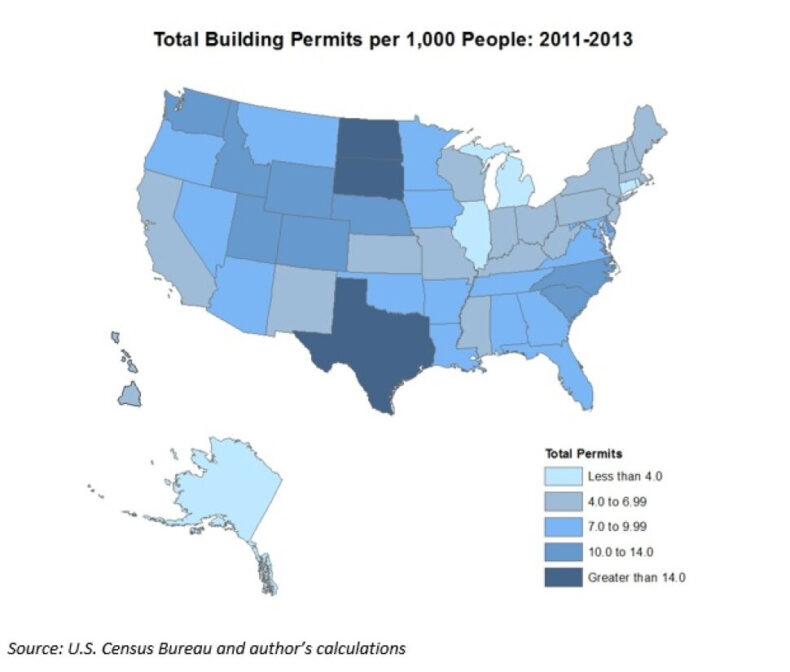
.
So low taxes, cheap housing, a growing finance, and tech scene have all contributed to the Southern States becoming richer and economically more important.
But there is, in my opinion, ultimately more to it than that.
The reality is that there is a cultural change occurring across more liberal states like California, which has made working, living, setting up a business and raising children, frankly, unbearable.
I have written on this platform before on the desperate state of crime in cities such as San Francisco. The effective decriminalisation of public drug use in California has created some of the most appalling scenes of homelessness, anti-social behaviour, drug abuse, and clear deprivation that many addicts live in. Considering California is the largest economy in the US, with the highest nominal level of State tax revenue, a huge economic base with (until recently) a large number of corporates situated there, it has found itself looking and feeling like a third world country. The decision to reduce sentencing and decriminalise drug abuse and antisocial behaviour was done, believe it or not, in the name of tackling racial injustice.
An effort to tackle racial injustice has heavily impacted the quality of education experienced in California’s school system. Education officials in the state have argued that elements of Maths education, namely algebra, are rooted in White Supremacy. California’s Instructional Quality Commission have published ‘A Pathway to Equitable Math Instruction‘ which it says will offer ‘an integrated approach to mathematics that centers Black, LatinX and Multilingual students in grades 6-8 [and] addresses barriers to math equity‘. It remarkably states that it also offers ‘opportunities for ongoing self-reflection as they seek to develop an anti-racist math practice.’ In effect, the new curriculum will be stripped of higher standard maths skills requirements. How important is maths? Pretty important if you want to take advantage of economic and social changes that will create more jobs in high-skilled areas of science and tech. But also pretty important if you want to be able to make sense of the world around you. It’s for that reason that Rishi Sunak introduced a requirement for students in the UK to do Maths until the age of 18. It’s why he said, ‘If we are going to grow the economy not just over the next two years, but the next twenty, we simply cannot allow poor numeracy to cost our economy tens of billions a year or to leave people twice as likely to be unemployed as those with competent numeracy‘.
Comparatively schools in New York have developed a reputation for infusing their educational offer with a strict anti-White Privilege and anti-racist mission. Paul Rossi, a teacher at a private school in Manhattan, went viral after writing an essay in the New York Post describing his experience of ‘Antiracist training’; being told that ‘objectivity’, ‘individualism’ and a ‘right to comfort’ were characteristics of white supremacy; of pushing back after being asked whether he was feeling ‘white feelings’; and then losing his job because his ‘philosophical challenges had caused “harm” to students, given that these topics were “life and death matters, about people’s flesh and blood and bone.”’
The UK learned at the beginning of this century that dumbing down education was the quickest way to deliver a sub-standard education system that produces people unprepared for work, unprepared for life, and unable to live independently.
It feels like a basic inability to govern effectively has suddenly befallen the state governments of New York and California. Californians have to put up with energy blackouts because of poor infrastructure investment, and wildfires (a consequence not of climate change but ineffective crisis management). New York has run out of sheltered accommodation for homeless people, leaving small clusters of tent cities in Midtown, a common sight on the West Coast.
Unsurprisingly, all this incompetence and culture shift is driving people away, and that is the reason the coastal states are beginning to struggle while the southern states are thriving. A media report did the rounds suggesting 300 people per day were leaving California for Texas. Similarly another report found 93,000 people left New York for Florida in 2021.
Between 2020 and 2022 Florida’s population grew by 3%. Obviously particular areas grew faster than others – counties around Fort Myers grew by 7%, the areas around Port St Lucie (north of Palm Beach and Miami) grew by more than 8%. The surrounding suburbs of Fort Worth and Dallas also grew by 7-8%. Comparatively San Francisco lost more than 7% of its population, New York nearly 5%.
Unsurprisingly, the most likely groups to move are the wealthiest (those hedgie and techie types) and the youngest (both are the most mobile groups in society, able to shoulder the cost of moving). They also happen to be economically essential. The San Francisco Chronicle ran a story in September of this year stating ‘Between 2021 and 2022, the number of San Franciscans ages 25 or older with a high school degree or less fell from 144,000 to 142,000, contributing to a 14% decline during the past three years‘.
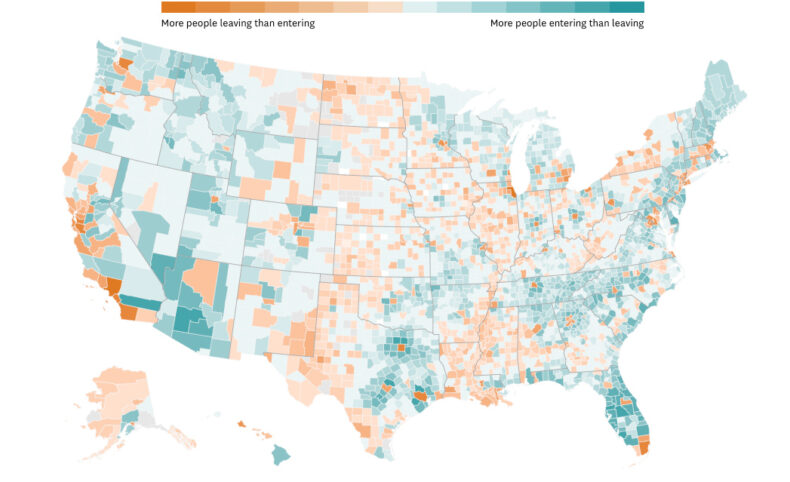
.
The point is that there is a significant shift in economic power that is clearly a consequence of both economic and social policy. The Southern States have rejected ‘wokeness’, embracing policies that have reduced costs and regulations for business as well as the cost of housing for families. Liberal coastal States have pursued more ‘muscular’ progressive policies on race, gender, education, and crime, while simultaneously choosing to neglect any effort to attract and retain big employers. The results speak for themselves. In a country with almost seamless borders, a relatively homogenous culture and language, you are witnessing the triumph of a set of ideas and governing principles over another. Policy makers in Britain should take note: states that prioritise free-enterprise, quality of life and quality public services win the day.
Click here to subscribe to our daily briefing – the best pieces from CapX and across the web.
CapX depends on the generosity of its readers. If you value what we do, please consider making a donation.


